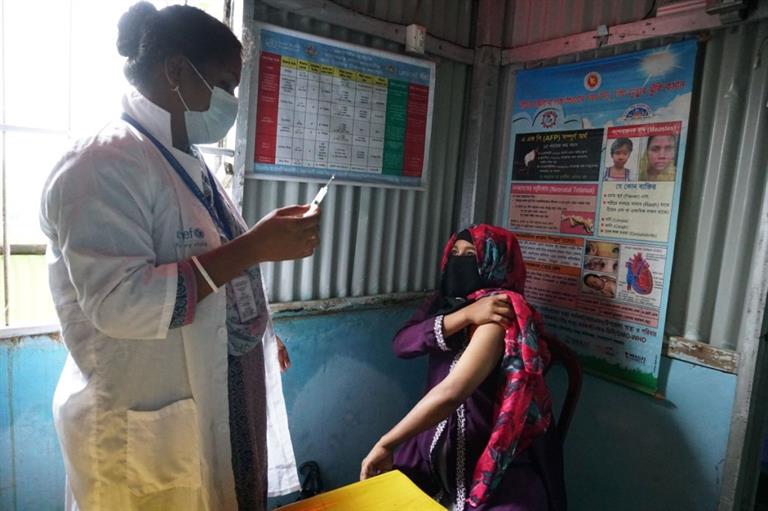Ensuring the continuity of essential health services in the world’s largest refugee camp has been a challenge since the onset of the COVID-19 pandemic. Highly impacted by the lockdown and subsequent disruption of health services, the routine immunization program in Cox’s Bazar is key to reduce the likelihood of outbreak-prone vaccine preventable diseases (VPDs) among the Rohingya refugees, such as polio and measles.
“COVID-19 has posed new challenges as patient’s health seeking behaviour changed significantly. We had to be creative and find alternatives to continue protecting children and pregnant women against vaccine-preventable diseases. In July, we implemented a new strategy and microplan and have since been monitoring its progresses”, says Dr Sujit Paul, WHO Emergency Immunization and Surveillance Officer (E-SIMO) in Ukhiya, Cox’s Bazar.
-in-cox-s-bazar-dr-sujit-paul.tmb-768v.jpg?Culture=en&sfvrsn=8719e942_1)
A WHO Emergency Immunization and Surveillance Officer (E-SIMO) in Cox’s Bazar, Dr Sujit Paul is providing technical support to prevent and control any VPD outbreak. WHO Bangladesh/ Tatiana Almeida
Vaccine-Preventable Disease surveillance is being closely monitored by government authorities with WHO’s technical support. SIMOs and Health field monitors (HFMs) continue to visit health facilities for surveillance, monitoring and investigation while contributing to the National acute flaccid paralysis (AFP) and vaccine-preventable diseases (VPD) surveillance systems. Currently, 13 health facilities have been identified as very high priority (VHP) and 38 as high priority (HP) active surveillance sites.
Coverage data shows an increasing trend on routine immunization in Cox’s Bazar but due to the slow pace of tracking and mobilization of unvaccinated and under vaccinated children, the immunization coverage remains low.
-team.tmb-768v.jpg?Culture=en&sfvrsn=d8223833_1)
WHO Immunization and Vaccines Development (IVD) team talking with Mousumi Rani Das, a community paramedic in Ukhiya, Cox’s Bazar. WHO Bangladesh/ Tatiana Almeida
“WHO continues to provide guidance regarding the operation and sustaining of immunization programs in the context of the COVID-19 pandemic. Due to the emergence and potential risks of transmission of wild poliovirus among Rohingya refugees, special attention has been given to preventing poliovirus. Since September 2017, the Ministry of Health and Family Welfare, Government of Bangladesh with the support of WHO, UNICEF and other partners conducted several immunization campaigns including five campaigns with bivalent oral poliovirus vaccine (bOPV) targeting children below five”, explains Dr Kai Von Harbon, WHO Head of Sub-Office in Cox’s Bazar.
Poliomyelitis (polio) is a highly infectious viral disease that largely affects children under 5 years of age. The virus is transmitted from person to person mainly through the faecal-oral route or, less frequently, by contaminated water or food, which multiplies in the intestine, from where it can invade the nervous system and cause paralysis.

Mousumi Rani Das, a community paramedic working as a vaccinator in Ukhiya, Cox’s Bazar since November 2019, preparing to vaccinate a pregnant Rohingya woman. WHO Bangladesh/ Tatiana Almeida
“Community Health Workers play a key role in mobilizing parents to bring their children to regular immunization sessions. They work closely with the vaccinators and follow up with children who missed their vaccines. A recent survey from WHO confirmed that 70% of the children were referred by CHWs. Without them, we wouldn’t be able to reach these families”, adds Sandra Harlass, UNHCR’s Public Health Officer in Cox’s Bazar.
Recently, WHO Health Field Monitors (HFMs) monitored 1058 immunization sessions to learn that the engagement with Community Health Workers (CHWs) is increasing, 97% of vaccinators were wearing face masks while 89% of caregivers were maintaining physical distance. WHO HFMs interviewed 1374 caregivers and 63% referred that CHWs asked them to attend vaccination sessions. HFMs also interviewed 662 Imams to find that 52% had low levels of engagement in the immunization program.

Abdul Gufur is a WHO Health Field Monitor in Ukhiya, Cox’s Bazar. WHO Bangladesh/ Tatiana Almeida
WHO E-SIMOs and Health Field Monitors (HFMs) contribute to maintain high quality surveillance to ensure vaccines and logistics distribution, cold chain management and proper field management in the Rohingya refugee camps. They actively search and investigate cases of polio, having identified 56 suspected cases in 2018, nine in 2019 and eight in 2020.
